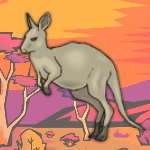
 |
Animal Sort |
Children love animals. This is a fun and enjoyable activity for children to test their ability to group various animals together according to their characteristics.
On opening the activity, a scene appears with ten animals in the sky and two sorting areas on the grass with signs next to them. The signs will be highlighted and named in turn, for example "live in water" or "more than four legs". The aim for children is to click and drag the animal onto the sorting area that has features that match with the sign. If placed onto the wrong sorting area, the animal will bounce back into its original position. The sign characteristic and animal can be named by clicking on them. When all animals have been sorted correctly there is cheering and a new set of randomly chosen animals and signs appear.
There are two levels of difficulty, indicated by the green circle in the lower left hand corner of the screen. Level two has twelve animals and three sorting areas.
To exit, click on the small hand in the lower right corner of the screen.
Outcome 4: Children are involved and confident learners
Outcome 5: Children are effective communicators
Identifying animals
Identifying characteristics of different animals
Sorting animals by characteristics
Decision-making
Mouse control: single click and click and drag
Children should have a good look at the animals and signs at the start of the game or when a new group appears. Encourage them to click on the signs again if they need to remind themselves of the features for which they are looking.
Some counting may be involved. Teachers can help younger children with counting legs and getting the idea of more or less of a required number.
Be aware that some animals may qualify for both or all of the sorting areas. ie. If the signs say "eats meat", "live in water" and "no legs"; than a shark can be placed in any one of them.
Some of the animal pictures may not show the required characteristic, but we know that the animal has it. For example, we can't see the elephant's tail. This explores the children's previous knowledge of animals. They may need help with animals that they have not had experience with. Encourage children to talk to each other and work collaboratively whilst playing this activity.
Use the game to start some discussion topics.